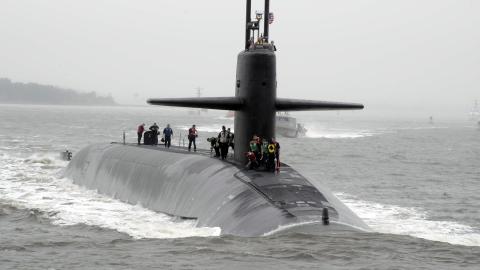A new and more dangerous nuclear era has now dawned. The United States is now approaching a geostrategic environment in which not a single nuclear warhead, anywhere in the world, is covered by an arms control treaty. Indeed, new treaties are needed to strengthen strategic stability and deterrence in this new era.
As recently described by Senator Debra Fischer of Nebraska and Representative Doug Lamborn of Colorado, two top leaders in Congress on nuclear matters, five major developments promise to undermine strategic stability and credible deterrence for the United States and its allies.
These include: (1) Russia’s continued and multiple threats to use nuclear weapons in Moscow’s war against Ukraine; (2) China’s breathtaking projected increase in nuclear weapons deployments including the building of 360 new intercontinental ballistic missile (ICBM) silos, placing China’s ICBM launcher count above that of the United States; (3) the Iranian government, which controls the largest ballistic missile arsenal in the Middle East, being on the cusp of building nuclear warheads as it enriches uranium well within the range of having weapons-grade material; (4) North Korea’s massive increase in missile testing; and (5) Russia’s on and off again compliance with the New START Treaty that is set to expire in 2026 if not renewed or replaced.
Note also the connection between the current armed conflicts in the world and these four “brothers in mayhem,” as one could describe China, Russia, North Korea, and Iran. The war against Ukraine is solely Russia’s design, while the other three either send Russia armaments or financial assistance including drones and missiles.
China and Russia now routinely exercise their militaries together including in the South China Sea, the Sea of Japan, and the Arctic, working together to intimidate Japan, Australia, and the Republic of Korea, as the region also worries about the invasion or blockade threats to Taiwan.
Similarly, the deployment and launch of hypersonic weapons by Russia or China from the Arctic, when taking into account ice shrinkage for part of the year, would bring such missile threats to within a few minutes of the continental United States.
Meanwhile, Iran makes war against Israel and U.S. interests in the Gulf, with guerilla war and hosting terrorist proxies in Lebanon, Yemen, Iraq, and Syria, while building a massive missile inventory. Now it seeks to build armament factories in Syria and Russia to avoid supply chain delays.
And North Korea, despite famine, launched more ballistic and cruise missile tests (fifty-four) in the past year than in the previous five years combined, all in the service of its continued invasion designs on the Republic of Korea and its international criminal enterprises.
In response to all four regional nuclear threats, the administration and its allies in Europe and Asia have generally joined together to propose more arms control.
Just this week, for example, the United States told Russia that it is ready to sit down and discuss New START and the future of arms control.
The United States has said the same to China, although the Chinese Communist Party has so far rejected any discussions out of hand, occasionally asserting discussions can take place only when the United States reduces its nuclear arsenal to no more than the (unknown) level of China’s deployed weapons.
The United States appears ready to continue talking with North Korea about the denuclearization of the Korean Peninsula, although the North continually asserts its nuclear forces are to stay to counteract the “hostile” policy of the United States toward Pyongyang.
As for Iran, the United States has made major concessions on trade and related sanctions, and continues to hope that the moribund Joint Comprehensive Plan of Action can be restored, bringing an end to Iran’s nuclear weapons ambitions.
The common thread among all of these efforts is the lack of any serious pushback against what these countries are doing. Serial violations of every nuclear arms deal have been documented by the U.S. Department of State for decades, starting as far back as the 1972 SALT nuclear arms Treaty, and yet Russia has not paid any serious price.
It is clear that arms control has failed to constrain the nuclear capabilities of Russia, China, Iran, and North Korea. When combined, formal arms control agreements apply—at best—to an estimated 33%-50% of the approximately 6,600 nuclear weapons held collectively by the four states. And that limiting function may decline to zero over the next decade, just as China’s nuclear force expands and New START expires, further eroding what transparency and predictability remain in the world’s nuclear arsenals.



















